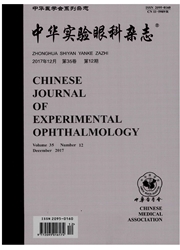

 中文摘要:
中文摘要:
背景角膜组织工程生物材料在体内应当具备透明性、一定的机械强度、生物相容性和缓慢降解的特点,丝素膜生物材料具备这些特征。目的研究采用物理交联再生丝素膜构建组织工程角膜的可行性。方法用常规培养法培养人角膜上皮细胞(CECs),将对数生长期的CECs在用家蚕丝制备的物理交联再生丝素膜上进行培养,分别于培养后24、48、72h在倒置显微镜、扫描电子显微镜下观察CECs的生长状态和形态学,并与细胞培养板培养的人CECs形态进行对照。MTT法每日检测和记录再生丝素膜培养后人CECs的增生情况,流式细胞仪检测再生丝素膜培养人CECs的细胞周期和凋亡率。将再生丝素膜4mm×3mm植入新西兰白兔右眼角膜基质层间,于术后1个月、2个月时裂隙灯下检查眼表,术后2个月摘除兔眼并制备移植眼角膜组织切片行组织病理学检查,观察再生丝素膜材料的降解情况及角膜新生血管(CNV)的生长情况。采用免疫组织化学法检测术后1个月、2个月CD34在移植眼角膜组织中的表达,并与正常眼进行对照。结果在24、48、72h3个时间点,倒置显微镜、扫描电子显微镜下见再生丝素膜培养的人CECs与细胞培养板培养法培养的人CECs形态结构无明显差别。再生丝素膜或细胞培养板培养CECs在1、2、3、4、5、6、7d各个时间点A490值比较,差异无统计学意义(F=0.641,P〉0.05)。再生丝素膜和细胞培养板培养的CECs凋亡率分别为1.8%、2.0%,细胞G2/G1期分别为1.956、1.945。再生丝素膜角膜植入后2个月时,再生丝素膜为排列整齐的胶原组织替代,角膜内新生血管和炎性细胞均少于移植后1个月。角膜免疫组织化学染色检测显示再生丝素膜植入角膜后1个月、2个月CD34表达量均明显低于Ad—VEGF165诱导的阳性对照,而与正常的角膜相比差异无统计学意义(P〉0.05)。术
 英文摘要:
英文摘要:
Background Biomaterials for corneal tissue engineering must demonstrate several critical features for potential utility in vivo, including transparency, mechanical integrity, bioeompatibility and slow biodegradation. Silk film biomaterial had been characterized to meet these functional requirements. Objective This study was to investigate the feasibility of physieo-erosslink regenerated silk fibroin film as tissue engineered corneal scaffold. Methods Human corneal epithelial cells (CECs) links were cultured by regular method and CECs in logarithmic phase were than incubated on physieo-erosslink regenerated silk fibroin film membrane. The shape of cultured human CECs was observed after 24,48 and 72 hours under the inverted microscope and scanning electron microscope(SEM) , and the CECs were cultured on culture plates as controls. The growth state of CECs on regenerated silk fibroin film was observed daily for 7 days by MTT,and cell cycle analysis and the presence of apoptosis of human CECs were examined by flow cytometry after incubation on regenerated silk fibroin film. Regenerated silk fibroin film- CECs (4 mm×3 mm) were implanted into the corneal stroma of the right eyes of New Zealand white rabbits. At the end of 4 and 8 weeks after implantation, the appearance of the ocular surface was examined using slit lamp and corneal neovascular area was measured. Corneal histopathological examination was carried out to assess the degradation of graft materials and immunohistochemistry was performed to detect the expression of CD34 in the corneal tissue after operation. Results The morphology and structure of CECs were identical using the two cultured Methods when observed under the inverted microscope and SEM after 24,48 and 72 hours. No significant difference was found in the A490 value 1,2,3,4,5,6 or 7 days after incubation on regenerated silk membrane and in culture plates ( Fmethod = 0. 641 ,P〉0.05). The apoptosis rates of CECs on regenerated silk membrane or culture plates were 1.8% and 2.0% and
 同期刊论文项目
同期刊论文项目
 同项目期刊论文
同项目期刊论文
 期刊信息
期刊信息
